Good morning everyone, and welcome back to another edition of Marvel Masterpieces Parallels in Masterpiece Theater here on Hipsters of the Coast!
I’m continuing my exploration of Upper Deck’s Marvel Masterpieces from 2016-2020, a continuation of my deep dive into the most recent Marvel Masterpieces 2020 set by Dave Palumbo. As I neared that series completion in 2021, I became curious about how Palumbo’s work would connect to the previous two “modern” Masterpiece sets that came before him. The 2016 set was done by Joe Jusko, artist of the first Marvel Masterpieces set in 1992. And in 2018, the hugely popular Italian comic artist Simone Bianchi followed in his footsteps, and completed his own Marvel Masterpieces set with new characters, new Battle Spectra scenes, and an entirely different stylistic take on the Marvel universe.
Each of the three sets are completely unique and puts an artist’s style in the full spotlight. Jusko’s look is classic comic book, with all the muscle, color, and vibrancy of the sets from the 1990s, but reimagined with nostalgia for a new century. Bianchi is more contemporary—darker and grittier with bold blacks and colored outlines to make his characters distinct and out of this world. Palumbo falls somewhere in the middle: his big brushstrokes give a painterly feel to the genre, and bring a balance to the modern Masterpieces. His rendition especially is something that trading cards have never seen.
Across the three sets 2016-2020, there are 42 characters that were painted into each set at least once, and several characters that have multiple appearances within a given year. In total we’ll look at more than 175 artworks throughout this series from each of the last three iterations of Marvel Masterpieces. We’ll compare and contrast each artist’s creation, and learn some pretty cool stuff directly from the artist’s themselves along the way. This series isn’t about picking the best work, but rather talking about why each is a Masterpiece in its own right, and how these works function as a family of premier illustrations both within and across their respective sets.
Today is a more challenging climb through the comic pages, as we seek to explore the idea of the anti-hero, their place in Marvel, and those characters that best exhibit those traits across the three sets. This is Parallels: Anti-Heroes!
What is an Anti-Hero?
Before we go too far, I’d like to define an anti-hero, both as a societal construct and within the confines of the Marvel Universe. We’ll save some time and go straight to Wikipedia:
“An antihero (sometimes spelled as anti-hero) or antiheroine is a main character in a story who lacks conventional heroic qualities and attributes, such as idealism, courage, and morality. Although antiheroes may sometimes perform actions that are morally correct, it is not always for the right reasons, often acting primarily out of self-interest or in ways that defy conventional ethical codes.”
While the first half of this definition is universally true, the second half is where we see this character type more specific to Marvel. Within our narrowed lens, we see “heroes” fighting bad guys, but often for skewed, personally fulfilling reasons, or in some cases, no reason at all. It’s this underlying chaos that makes these characters so appealing to follow and collect, as you never know their next move, and makes them particularly interesting to study across their wide range of artworks. Let’s begin.
Deadpool
Wade Wilson, better known as Deadpool, is probably the most recognizable character of these four no doubt because of the success of his film adaptations in 2016 and 2018. He began his comic journey as a bad guy when he first appeared in 1991, but was quickly adapted to the comic-relief anti-hero of pure chaotic fun we see today, known for breaking the fourth wall with a wit sharper than both his swords.
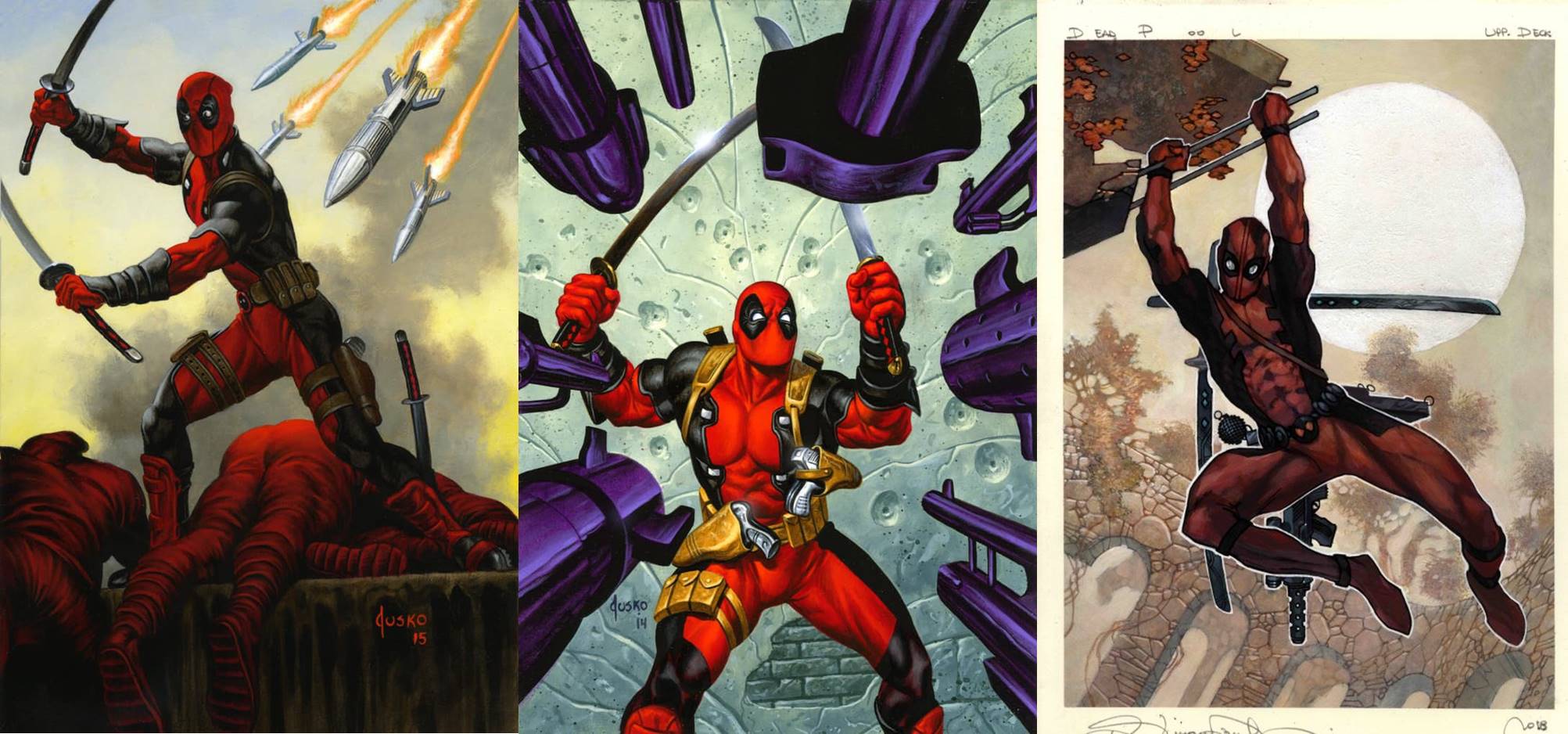
Left to Right: Deadpool (Holofoil) by Joe Jusko, 2016; Deadpool (Base) by Joe Jusko, 2016; Deadpool by Simone Bianchi, 2018.
Within the Masterpieces set we witness this same evolution of Deadpool. Jusko’s pair of pieces show the character very much as a classic superhero, and how he would have begun back in the early 1990s. The “bringing a knife to a gunfight” idea rings true, and then we see him about to get his butt blown off even after beating the bad guys. Moving right, Bianchi puts the Merc with a Mouth in one of many precarious positions, but it’s more or less how we’ve come to expect to encounter Wilson when he’s out and about.
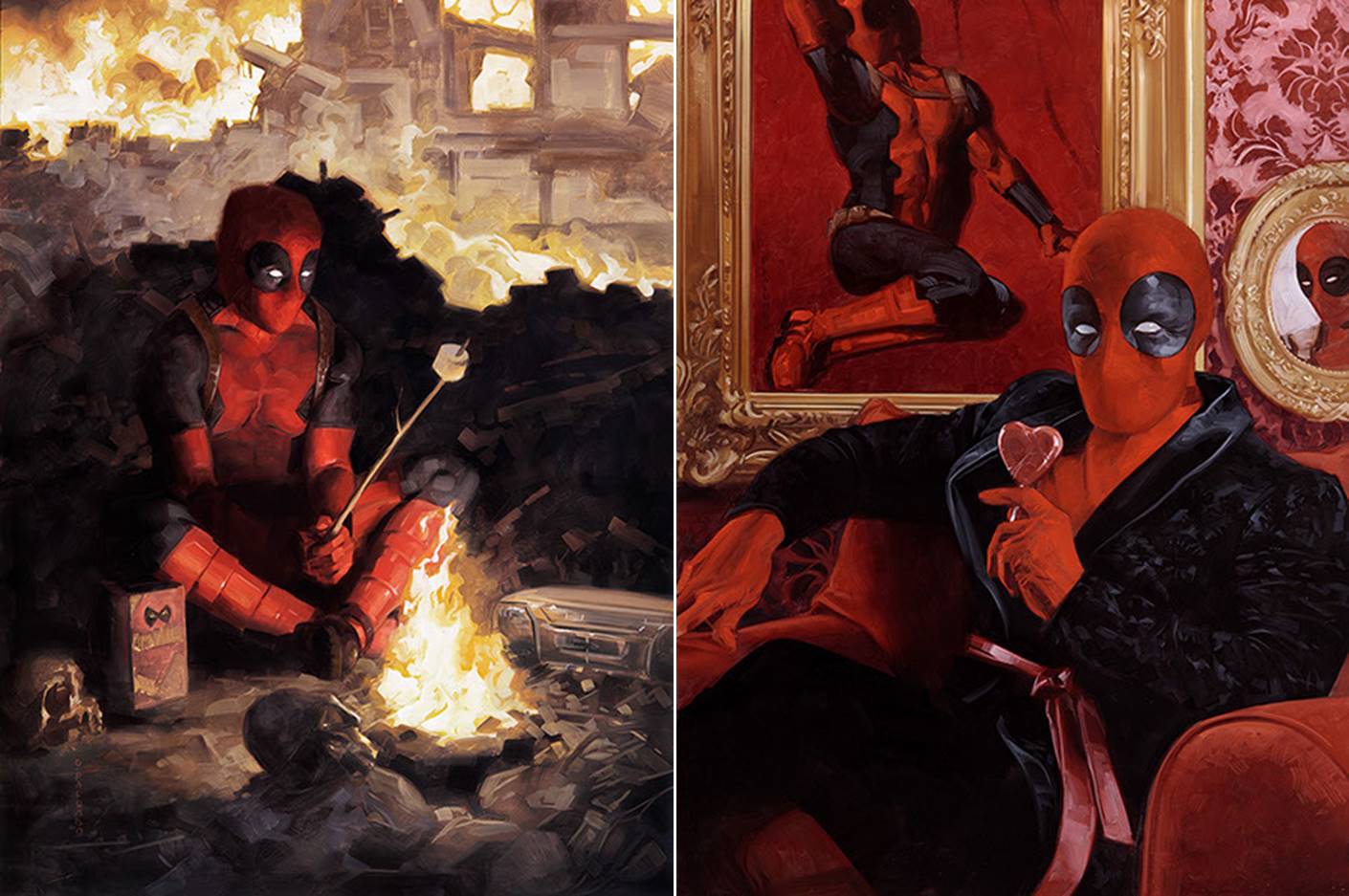
Left: Deadpool (Base) by Dave Palumbo, 2020. Right: Deadpool (Holofoil) by Dave Palumbo, 2020.
Palumbo takes a more contemporary path, and leans into the character’s comedic side full tilt, perhaps the most original of any Deadpool depiction across trading card sets to date. His base set card shows our hero toasting marshmallows at the center of his self-created devastation,. and his holofoil version is a love letter to who else but himself, a brilliant painting in its own right and full of fun. See below.
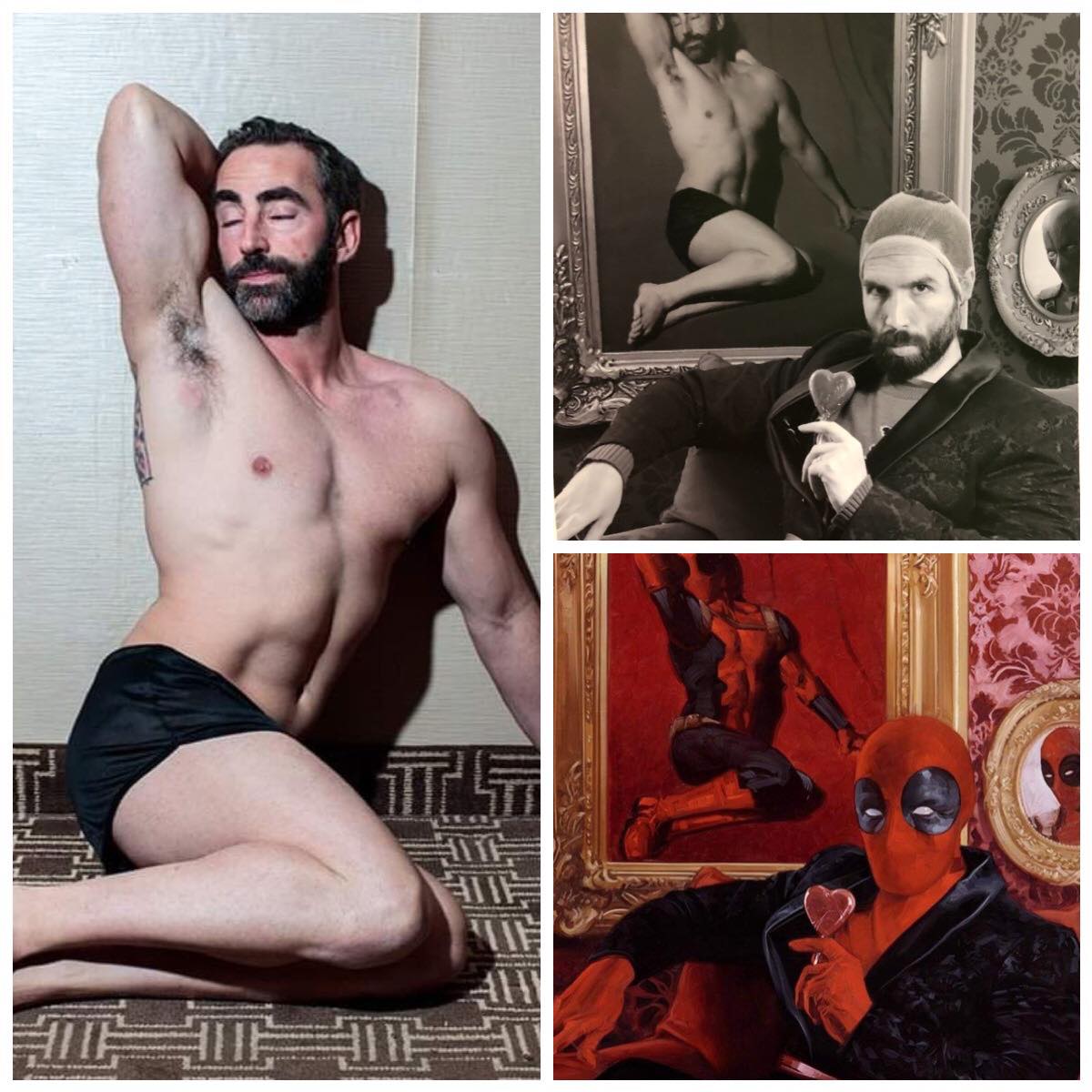
Reference Images for Deadpool (Holofoil) by Dave Palumbo. Model Pat King poses as Marilyn Monroe, and Palumbo himself as Valentine’s Day Deadpool in the bottom right.
Punisher
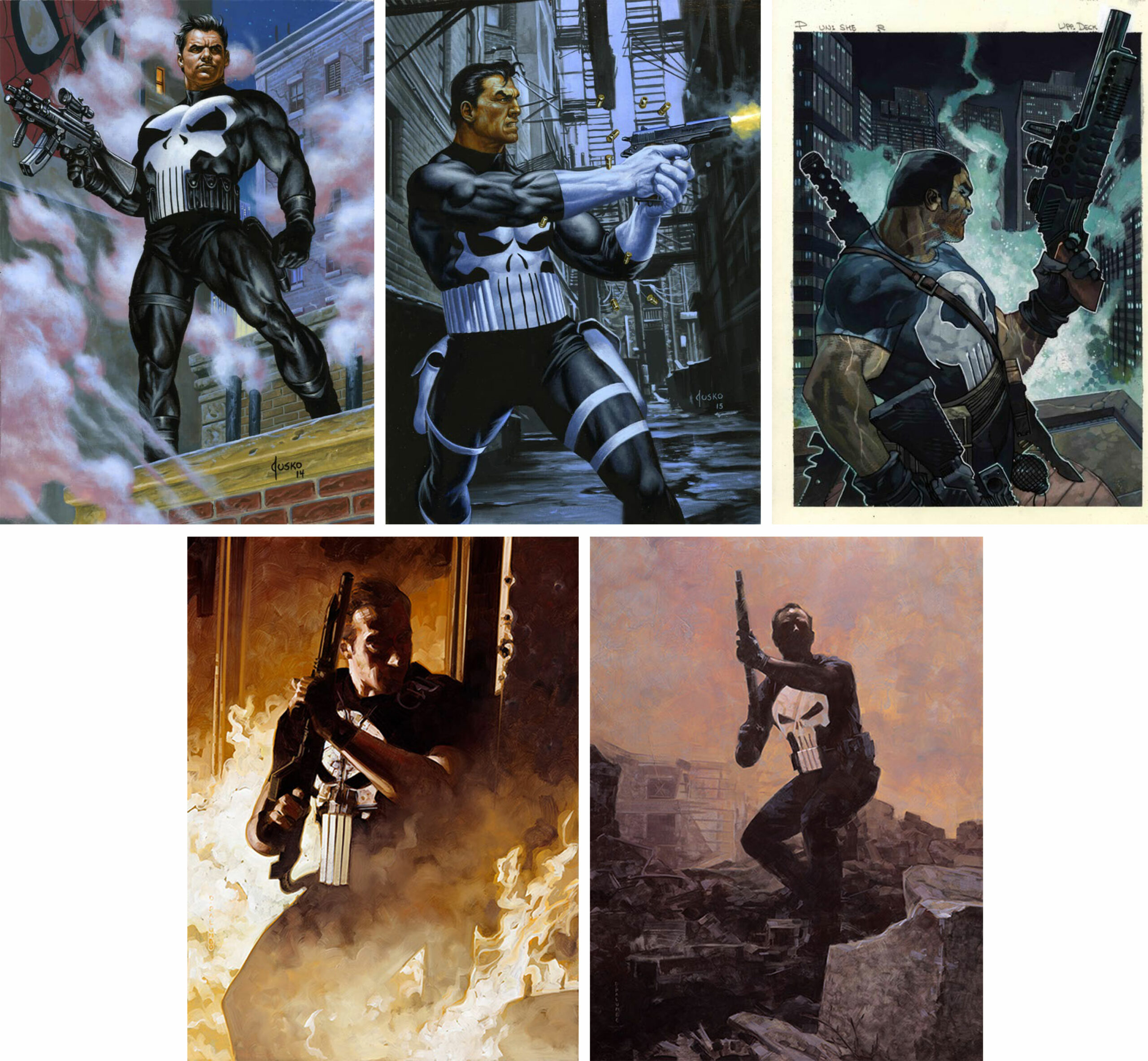
Left to right: Punisher (Base) by Joe Jusko, 2016; Punisher (Holofoil) by Joe Jusko, 2016 Punisher by Simone Bianchi, 2018; Punisher (Holofoil) by Dave Palumbo, 2020; Punisher (Base) by Dave Palumbo, 2020.
Frank Castle, known to comic fans as the Punisher, is a vigilante superhero committed to outing organized crime wherever it may exist. Originally an adversary of Spider-Man (The Amazing Spider-Man #129 (Feb. 1974)), he would go on to join Spidey and other Avengers in their crime-fighting adventures throughout the rest of the 20th century.
Looking at these five works across a half a decade, we see one thing. A descent.
Jusko’s Punisher is depicted bright and heroic amongst the tenements of New York City, stoic and standing at the ready to fight any who threatened his city. Bianchi’s Punisher begins to turn from the camera, almost contemplative to the rising smoke and the city he’s assumed to protect. Palumbo’s pair of Punishers are the last original art we’ve seen in Marvel trading cards over the last two years. In both of his works, The Punisher’s face further recedes from view into shadow, a mercenary who is still out there fighting, but further blurring the line between who is good and who is evil.
The Punisher (more specifically, his death skull logo), has become the center of controversy in recent years from its adoptions by military, police, and extremist groups, and as such his future in Marvel trading cards is still yet to be seen. Will he appear in the 2022 Masterpieces set? Time will tell.
Man-Thing
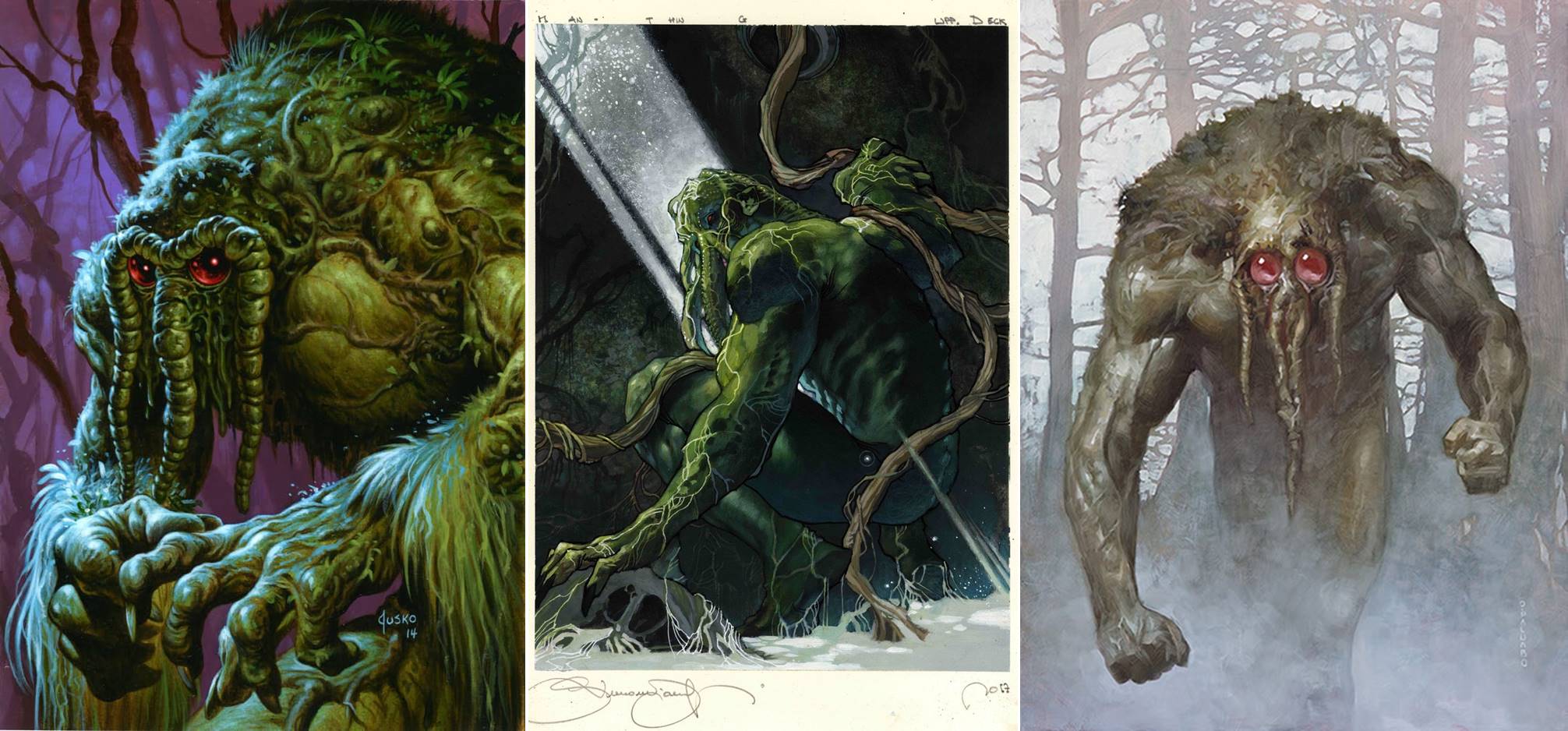
Left to right: Man-Thing by Joe Jusko, 2016; Man-Thing by Simone Bianchi, 2018; Man-Thing by Dave Palumbo, 2020.
Man-Thing may seem like an unusual inclusion here, but anti-hero is indeed perhaps the best place for him within this series. Originally Dr. Theodore “Ted” Sallis, the Man-Thing came into being when a betrayed Sallis, who was working on recreating the Captain America super-serum, fled his lab but crashed into the Florida Everglades. A combination of scientific and magical matter transformed him into the creature we see above, most characterized by those sullen red eyes. He spends much of his storyline as an accidental hero, using his ability to read human emotions to confront those that threaten his new way of life.
Each artist above has done a brilliant job of capturing the emotive nature of this creature. Jusko notes in his book that painting Man-Thing was an itch he longed to scratch, and that this was simply a springboard to further exploration of the character. Bianchi’s depiction recoils away from the viewer, a nod to the monster’s now solitary existence. And Palumbo, perhaps better than any artist before him, imbues a softness and sadness into the Man-Thing’s signature red eyes as he emerges from the mist.
Ghost Rider
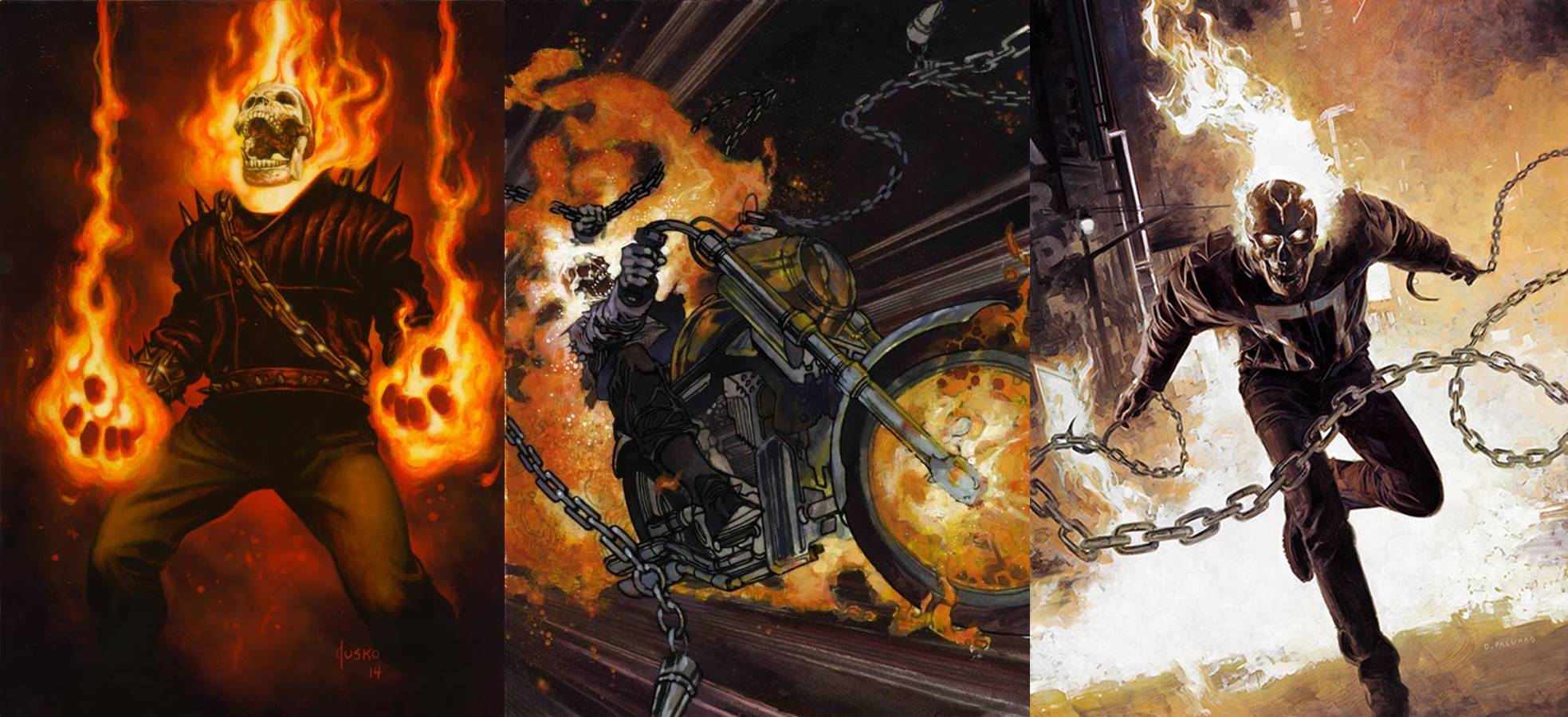
Left to Right: Ghost Rider by Joe Jusko, 2016; Ghost Rider by Simone Bianchi, 2018; Ghost Rider by Dave Palumbo, 2020.
The man known as Ghost Rider has taken many forms and persona since his debut in 1972, but most often he appears as Johnny Blaze, a supernatural stunt motorcyclist who sold his soul to the demon Mephisto to save his father. He now spends his nights and crime-fighting adventures consumed by hellfire, riding a fiery motorcycle, and blasting any bad guys that get in his way.
Jusko made particular mention in his book about Ghost Rider’s ride: “I make no bones about it: I did not want to paint that damn motorcycle!” The result is a masterclass in Burnt Umber, that, in place of black paint, makes his Ghost Rider feel hotter than hell itself. Bianchi opted for the motorcycle, which is exciting to see, and this captures Johnny-Cakes as many of us know him best. Palumbo opted again for a vehicle-less villain, and his Ghost Rider approaches and engages the viewer directly. He all but breaks the border, and we’re about to be on the business end of his swinging chain.
Wrapping Up
The idea of portraying an anti-hero is no easy task, to try and create a character that is both captivating and heroic, but yet not quite in the same vein as those of normal convention. It opens up a lot of possibilities for fun and frivolity, or seriousness and self-contemplation, and it’s this diversity of emotion that makes these characters so compelling.
Our next edition of Parallels will be all but our last (maybe), and focus on those extraterrestrial or intergalactic heroes unique to Marvel found across the stars. We’re still eagerly waiting for any announcement of the next Marvel Masterpieces for 2022, or any original art set for that matter, so stay tuned for what must be an eventful coming up. You can keep up with all things Marvel Masterpieces 2020 by following me on Twitter. Feel free to ask questions or retweet to continue the conversation. Thanks and see you next time!
Donny Caltrider has been playing Magic since 2002 and collecting original Magic art since 2017. He has an M.A. in Museum Studies from Johns Hopkins University and enjoys telling stories about art, objects, and the intersection of fantasy with real-life. You can find him on Twitter talking about #mtgart, museums, and other #vorthos related goodness. Follow along and continue the conversation!

